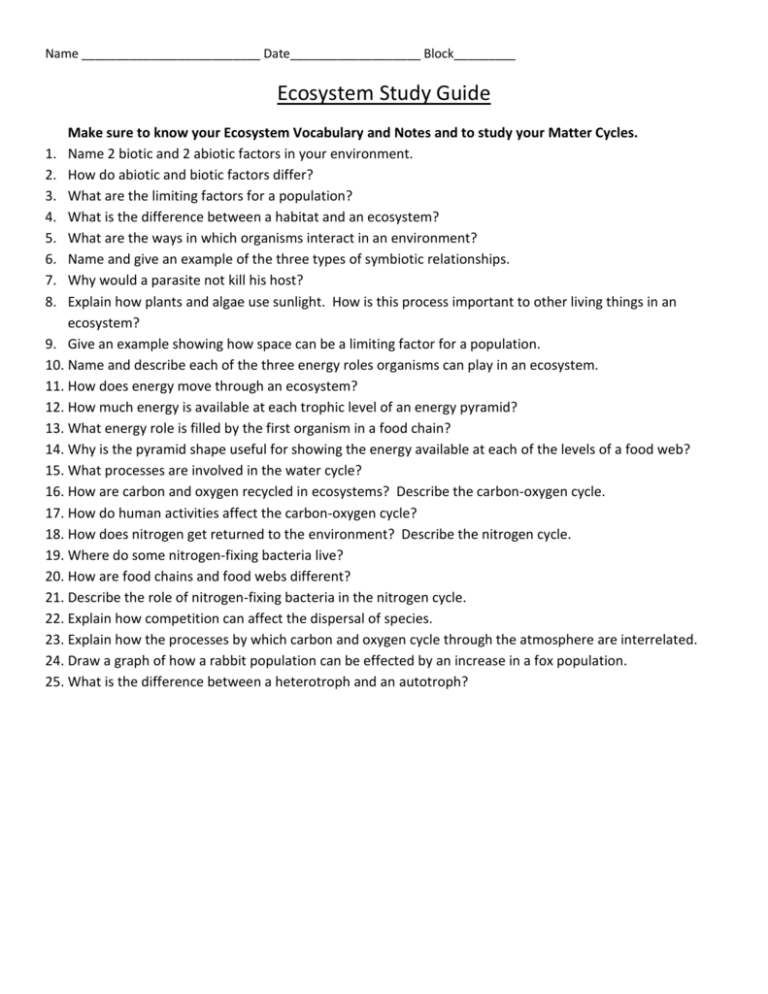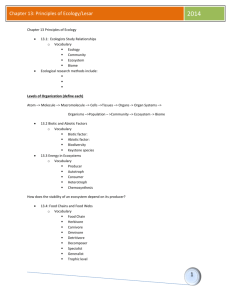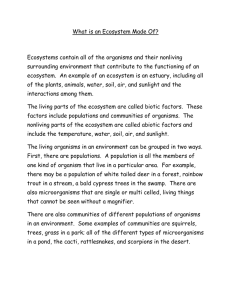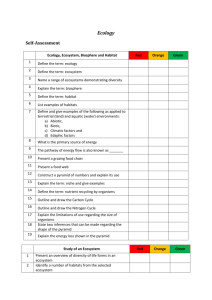Ecosystem Study Guide
advertisement

Name __________________________ Date___________________ Block_________ Ecosystem Study Guide Make sure to know your Ecosystem Vocabulary and Notes and to study your Matter Cycles. 1. Name 2 biotic and 2 abiotic factors in your environment. 2. How do abiotic and biotic factors differ? 3. What are the limiting factors for a population? 4. What is the difference between a habitat and an ecosystem? 5. What are the ways in which organisms interact in an environment? 6. Name and give an example of the three types of symbiotic relationships. 7. Why would a parasite not kill his host? 8. Explain how plants and algae use sunlight. How is this process important to other living things in an ecosystem? 9. Give an example showing how space can be a limiting factor for a population. 10. Name and describe each of the three energy roles organisms can play in an ecosystem. 11. How does energy move through an ecosystem? 12. How much energy is available at each trophic level of an energy pyramid? 13. What energy role is filled by the first organism in a food chain? 14. Why is the pyramid shape useful for showing the energy available at each of the levels of a food web? 15. What processes are involved in the water cycle? 16. How are carbon and oxygen recycled in ecosystems? Describe the carbon-oxygen cycle. 17. How do human activities affect the carbon-oxygen cycle? 18. How does nitrogen get returned to the environment? Describe the nitrogen cycle. 19. Where do some nitrogen-fixing bacteria live? 20. How are food chains and food webs different? 21. Describe the role of nitrogen-fixing bacteria in the nitrogen cycle. 22. Explain how competition can affect the dispersal of species. 23. Explain how the processes by which carbon and oxygen cycle through the atmosphere are interrelated. 24. Draw a graph of how a rabbit population can be effected by an increase in a fox population. 25. What is the difference between a heterotroph and an autotroph? Name __________________________ Date___________________ Block_________ Ecosystem Study Guide Make sure to know your Ecosystem Vocabulary and Notes and to study your Matter Cycles. 1. Name 2 biotic and 2 abiotic factors in your environment. 2. How do abiotic and biotic factors differ? 3. What are the limiting factors for a population? 4. What is the difference between a habitat and an ecosystem? 5. What are the ways in which organisms interact in an environment? 6. Name and give an example of the three types of symbiotic relationships. 7. Why would a parasite not kill his host? 8. Explain how plants and algae use sunlight. How is this process important to other living things in an ecosystem? 9. Give an example showing how space can be a limiting factor for a population. 10. Name and describe each of the three energy roles organisms can play in an ecosystem. 11. How does energy move through an ecosystem? 12. How much energy is available at each trophic level of an energy pyramid? 13. What energy role is filled by the first organism in a food chain? 14. Why is the pyramid shape useful for showing the energy available at each of the levels of a food web? 15. What processes are involved in the water cycle? 16. How are carbon and oxygen recycled in ecosystems? Describe the carbon-oxygen cycle. 17. How do human activities affect the carbon-oxygen cycle? 18. How does nitrogen get returned to the environment? Describe the nitrogen cycle. 19. Where do some nitrogen-fixing bacteria live? 20. How are food chains and food webs different? 21. Describe the role of nitrogen-fixing bacteria in the nitrogen cycle. 22. Explain how competition can affect the dispersal of species. 23. Explain how the processes by which carbon and oxygen cycle through the atmosphere are interrelated. 24. Draw a graph of how a rabbit population can be effected by an increase in a fox population. 25. What is the difference between a heterotroph and an autotroph?








